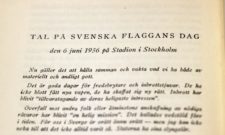Shop our historical maps
History
Three reasons for the great Swedish migration to America

May
Share on FacebookShare on WhatsAppShare on TelegramShare on X (Twitter)Bild: Svenskar i Amerika. Olof Olsson från Nerikes Kil, utvandrade omkring 1880 till Rush City, Minnesota. Utvandrarens visa är skriven av Wilhelm von Braun och trycktes i Carlshamn 1868 vid en tid då emigrationen från Sverige började få […]
Photo: Swedes in America. Olof Olsson from Nerikes Kil, emigrated around 1880 to Rush City, Minnesota.
The emigrant's visa was written by Wilhelm von Braun and printed in Carlshamn in 1868 at a time when emigration from Sweden was beginning to take on truly significant proportions. Here is a sample:

The song rhymes well with what Vilhelm Moberg describes in his book "The Unknown Family", which is about the millions of descendants of the Swedes who emigrated to North America during the Great Swedish Migration.
An early reason for the emigration was ecclesiastical unrest. It was forbidden to hold religious gatherings outside the walls of the state church. This reason disappeared in 1858 when the decree was repealed.
Another reason Moberg mentions, which arose in 1901, was when conscription was extended to three years. "During the first decade of the new century, many thousands of young Swedish men went to America to avoid the exercise."
Many young Swedes who emigrated were left without housing and economic opportunities in Sweden. They saw the possibility of saving money for their own farm as non-existent. They also complained about short and irregular jobs and high taxes.
A young man, G. F. M. who emigrated from Jämtland to Illinois in 1905, tells us:
[...] "In the spring of 1905 I received my removal certificate and left for the free land of the republic with joy in my heart. It was not only the poor working conditions that drove me to leave Sweden, the class difference and the long military service stood like menacing ghosts and looked darkly upon me. I heard from comrades that when you got out on the drill ground you had to be called idiot, drummel, coward, you stupid dj-l and many other beautiful names, and I wanted to save these titles for the son of a rich man."
As a lumberjack in Norrland, he was paid SEK 2 a day to work "from daybreak until nightfall", which in the Norrland summers could last well into the evening. In America, his terms were "50 cents an hour, 8 hours' work, a clean and neat room for $5 a month, and a nice table to sit at for $4 a week."
"But one of the causes of emigration," writes Moberg, "seems to have remained unchanged through a hundred years, namely dissatisfaction with bureaucracy and officialdom in Sweden and with all the laws that inhibit freedom."
"They make life unbearable in this country and are like a corrosive mask on the fabric of society," writes one of the early emigrants.
During Moberg's stay in America, he met many compatriots who had emigrated in recent years, even into the 1940s, and when he asked why, he received the same answer in nine cases out of ten:
"Dissatisfaction with the authorities, with all the laws and regulations that restrict freedom, with the rule of officials here at home. In the Sweden of the four states there was a personal, partriarchal oppression; in Social Democratic Sweden the oppression is exercised by an impersonal, mechanically functioning state apparatus - that is the difference."
Stifling bureaucracy and patronage drove many a Swede into exile to seek their fortune across the sea to the west.
As an example of the enormous Swedish bureaucracy and government (in)efficiency, one need look no further than Emigration inquiry. A government inquiry was set up in 1907 to investigate how Sweden could slow down emigration. By this time, one-fifth of all Swedes were living in the United States.

The authorities in Sweden were very concerned about the exodus of their subjects. Some saw the exodus as a challenge to national solidarity, while others were concerned about the loss of labour. Then, as now, a larger population meant more labour to tax. But ordinary people also worried about seeing entire villages around them literally emptied of people.
So much for government "efficiency". By the time the investigation got underway, emigration had already been going on for over 50 years and, as Vilhelm Moberg remarks in "The Unknown Family", "it seems to us that this investigation was begun somewhat late".
Late shall the sinner awake. But now the investigation was on! It took 6 years to complete, and the results were published in 21 comprehensive volumes.
"It was so thorough that it reached down to the soil, to the topsoil and the alva, in every Swedish parish." Moberg wrote.
"But", as Moberg concludes the subject, "when the Emigration Inquiry was completed, emigration was also practically over."
Just one year after the Commission published its last volume, the First World War broke out, effectively halting almost all emigration, and in the 1920s Swedish mass emigration ceased.
First, American immigration laws were tightened in 1924 (Immigration Act of 1924The federal law limited immigration from each country to 2 % of the number from the same country living in the United States at the 1890 census.
According to that census, there were around 800,000 Swedes living in the US in 1890, which with the new law capped the number who could immigrate from Sweden at around 16,000 per year. The main goal of the law was to try to preserve a "homogeneous American ideal."
Finally, social reforms were implemented in Sweden which, combined with increased prosperity, may have contributed to reducing emigration.
Subscribe to YouTube:
If you appreciate Allmogens independent work to portray our fine Swedish history and Nordic culture, you are welcome to buy something nice in the shop or support us with a voluntary donation. Thank you in advance!
Support Allmogens via Swish: 123 258 97 29
Support Allmogens by becoming a member
Support Allmogens in your will








